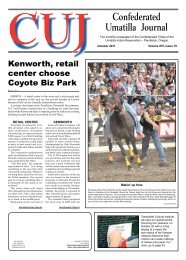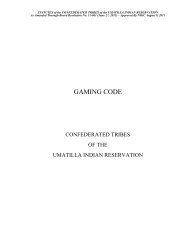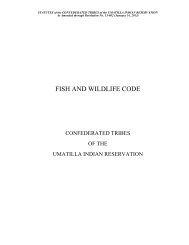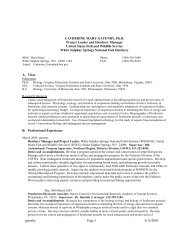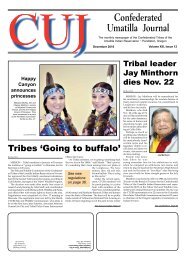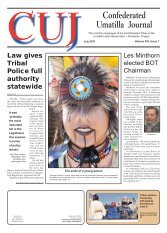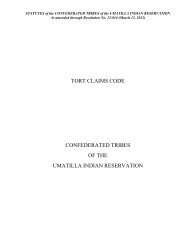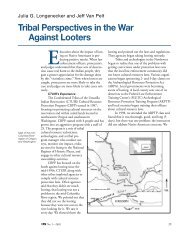November 2011 CUJ - Confederated Tribes of the Umatilla Indian ...
November 2011 CUJ - Confederated Tribes of the Umatilla Indian ...
November 2011 CUJ - Confederated Tribes of the Umatilla Indian ...
- No tags were found...
Create successful ePaper yourself
Turn your PDF publications into a flip-book with our unique Google optimized e-Paper software.
Condit Dam breached; White Salmon runs freeBy SHANNON DININNY, Associated PressA muddy stew <strong>of</strong> black silt and waterroared through a hole breached by workersin a nearly century-old dam Oct. 26 inWashington’s south Cascades, markingano<strong>the</strong>r step in ongoing efforts to restorehabitat for threatened and endangeredfish in <strong>the</strong> Pacific Northwest.The more than 12-story Condit Damon <strong>the</strong> White Salmon River is <strong>the</strong> secondtallestdam in U.S. history to be breachedfor fish passage, according to <strong>the</strong> advocacygroup American Rivers.Its two turbines produced about 14megawatts <strong>of</strong> power, enough for 7,000homes. But its owner, Portland-basedutility PacifiCorp, elected to remove <strong>the</strong>dam ra<strong>the</strong>r than install cost-prohibitivefish passage structures that would havebeen required for relicensing.``This is a very important day for <strong>the</strong>river and <strong>the</strong> community,’’ AmericanRivers spokeswoman Amy Kober said.``We’re not just talking about restoringvital fish runs in <strong>the</strong> region but improvinga nationally renowned whitewater area.’’The White Salmon River winds fromits headwaters on <strong>the</strong> slopes <strong>of</strong> MountAdams through steep, forested canyonsto its confluence with <strong>the</strong> ColumbiaRiver, <strong>the</strong> largest river in <strong>the</strong> PacificNorthwest.The 125-foot Condit Dam, which wasbuilt in 1913, blocked fish passage for nativespecies <strong>of</strong> Pacific salmon and o<strong>the</strong>ranadromous fish that mature in <strong>the</strong> oceanand return to rivers to spawn, confining<strong>the</strong>m to <strong>the</strong> lower 3.3 miles <strong>of</strong> <strong>the</strong> river.Removing <strong>the</strong> dam and restoring aPLEASE SUPPORTBOB SHIPPENTOWERFOR RE-ELECTION TO BOT ON NOV. 15• ANALYTICAL/CONCEPTUAL AND WRITING SKILLS• EXPERIENCE – CURRENT TERO COMMISSION CHAIRMAN, HEALTHCOMMISSION MEMBER, LAND ACQUISITION COMMITTEE MEMBER,BOT VETERANS DELEGATE, BOT TRANSPOR-TATION DELEGATE, YELLOWHAWK PROJECTTEAM MEMBER, FORMER EDUCATION COM-MITTEE, FORMER ENROLLMENT COMMIT-TEE MEMBER, FORMER WATER COMMITTEECHAIRMAN• EDUCATION – COLLEGE, UNIVERSITY OFOREGON. GRADUATE SCHOOL, UNIVERSITYOF CALIFORNIA AT BERKELEY• MILITARY SERVICE – VIETNAM VETERAN,NON-COMMISSIONED OFFICER IN COMBATINFANTRY UNIT.Emily Washines, a tribal member andremediation and restoration coordinator forYakama fisheries, said her grandfa<strong>the</strong>r, bornin 1915, never saw <strong>the</strong> free-flowing river.‘My sister and I will be able to see <strong>the</strong> river<strong>the</strong> way our great-grandparents saw it. Theresurgence <strong>of</strong> cultural activities and renewinga sense <strong>of</strong> what that means for our futuregenerations is on <strong>the</strong> brink <strong>of</strong> happening.’free-flowing river will open up miles<strong>of</strong> new habitat for fish and likely createadditional recreational opportunities forkayakers and rafters in a region alreadyknown among whitewater enthusiasts.Sirens sounded several times to warnabout <strong>the</strong> impending blast shortly afternoon, <strong>the</strong>n black silt and water beganpouring through <strong>the</strong> hole that wasbreached with 700 pounds <strong>of</strong> explosives,splashing up <strong>the</strong> sides <strong>of</strong> <strong>the</strong> rocky canyon.PacifiCorp posted a live video feed<strong>of</strong> <strong>the</strong> event on its website, and localresidents, conservation groups, and recreationenthusiasts held viewing partiesto celebrate <strong>the</strong> event.More than 100 people downed pizzaand beer at Wet Planet Whitewater, ariver rafting and guiding company. Theyscreamed and whooped as <strong>the</strong> dam blew,<strong>the</strong>n a great cheer went through <strong>the</strong> tentset up for <strong>the</strong> party.Alexa Williams, 26, was born in <strong>the</strong>community <strong>of</strong> White Salmon and lives inHusum, working at Wet Planet, during<strong>the</strong> summer season. An avid rafter andbeginning kayaker, she first floated <strong>the</strong>river when she was 10 years old.``It’s going to be neat to see what’sunderneath <strong>the</strong> water,’’ she said in atelephone interview from <strong>the</strong> partyin Husum. ``Not that I’m <strong>the</strong> level <strong>of</strong>kayaker who could kayak it yet, but itwould be pretty cool if <strong>the</strong>re were somebig drops in <strong>the</strong>re.’’Yakama tribal members viewed a livefeed <strong>of</strong> <strong>the</strong> event in an auditorium on<strong>the</strong>ir reservation. Area biologists did <strong>the</strong>same at <strong>the</strong> Spring Creek National FishHatchery.About 150 people ga<strong>the</strong>red at <strong>the</strong> damto watch <strong>the</strong> blast, including <strong>the</strong> triballeaders <strong>of</strong> four area tribes - <strong>Umatilla</strong>,Yakama, Warm Spring and Nez Perce.Some were visibly moved by <strong>the</strong> event.Yakama Nation tribal elders havecalled <strong>the</strong> area a ``paradise,’’ recallingstories about tribal members fishing,hunting and ga<strong>the</strong>ring berries and o<strong>the</strong>rnative plants before <strong>the</strong> dam was built.Tribal houses and drying sheds sat at<strong>the</strong> confluence with <strong>the</strong> Columbia forprocessing abundant salmon, steelheadand lamprey.Emily Washines, a tribal member andremediation and restoration coordinatorfor Yakama fisheries, said her grandfa<strong>the</strong>r,born in 1915, never saw <strong>the</strong> freeflowingriver.``My sister and I will be able to see <strong>the</strong>river <strong>the</strong> way our great-grandparents sawit,’’ she said. ``The resurgence <strong>of</strong> culturalactivities and renewing a sense <strong>of</strong> whatthat means for our future generations ison <strong>the</strong> brink <strong>of</strong> happening.’’Removal <strong>of</strong> <strong>the</strong> dam opens up at least33 miles <strong>of</strong> habitat for steelhead. Habitatfor tule fall chinook will double.Yakama Nation chairman HarrySmiskin likened <strong>the</strong> return <strong>of</strong> fish to <strong>the</strong>river’s upper stretches to ``welcomingback a relative that has been missing formany years.’’``It is sad that <strong>the</strong> dam is coming out,but again, it is a return to something ourCreator, our Mo<strong>the</strong>r Nature, created forus and to put it back to as close to itsnatural state as it can be,’’ he said.In recent weeks, work crews created atunnel 18 feet wide and 13 feet tall in <strong>the</strong>base <strong>of</strong> <strong>the</strong> dam to allow water and sedimentto pass through from <strong>the</strong> reservoirbehind <strong>the</strong> dam once it is breached. Over<strong>the</strong> years, a five-story wedge <strong>of</strong> silt hascollected in 92-acre Northwestern Lake,a popular recreation spot for boaters and<strong>the</strong> dozens <strong>of</strong> cabin leaseholders on <strong>the</strong>water’s edge.Fisheries biologists also captured andrelocated 679 tule chinook from below <strong>the</strong>dam to <strong>the</strong> river above it to protect <strong>the</strong>irredds, or spawning nests, from beinginundated by sediment.PacifiCorp has estimated <strong>the</strong> dam removalproject at $33 million, far less than<strong>the</strong> $100 million improvements and fishladders that would have been required byfederal regulators to relicense <strong>the</strong> dam.Fish ladders were incorporated on <strong>the</strong>dam when it was first built, but stormstwice tore down <strong>the</strong> structures.Demolition <strong>of</strong> <strong>the</strong> remaining portion <strong>of</strong><strong>the</strong> dam is scheduled to begin in spring2012 and be completed by Aug. 31,2012. Restoration <strong>of</strong> <strong>the</strong> former reservoirshould be completed by <strong>the</strong> end <strong>of</strong> 2012.In <strong>the</strong> largest dam removal project inU.S. history, workers last month beganremoving <strong>the</strong> 210-foot Glines CanyonDam and <strong>the</strong> 108-foot Elwha Dam from<strong>the</strong> Elwha River in Washington, part<strong>of</strong> a three-year $325 million project torestore <strong>the</strong> Olympic Peninsula river andits salmon runs.IF ELECTED, I WILL BE ACCOUNTABLE TO TRIBAL MEMBERSHIP ANDWILL CONTINUE TO WORK TO ENSURE TRIBAL POLICIES REFLECTTRIBAL VALUES AND PRINCIPLES, INCLUDING INTEGRITY, JUSTICE,FAIRNESS AND COMPASSION.THANK YOU. 541-310-7048Paid Political Ad32 <strong>Confederated</strong> <strong>Umatilla</strong> Journal<strong>November</strong> <strong>2011</strong>





